Trade names Tasmar MedlinePlus a698036 CAS ID 134308-13-7 | AHFS/Drugs.com Monograph Molar mass 273.241 g/mol Trade name Tasmar | |
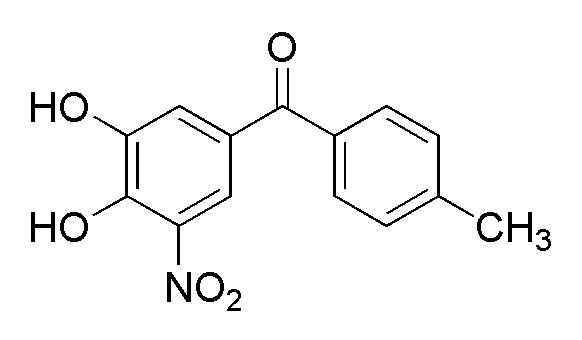 | ||
Pregnancycategory US: C (Risk not ruled out) | ||
How to pronounce tolcapone
Tolcapone (brand name Tasmar) is a drug used to treat Parkinson's disease (PD). It is a selective, potent and reversible nitrocatechol-type inhibitor of enzyme catechol-O-methyltransferase (COMT).
Contents
- How to pronounce tolcapone
- Uses
- Chemistry
- History
- Pharmacodynamics
- Pharmacokinetics
- Treatment
- Adverse effects
- Synthesis
- References
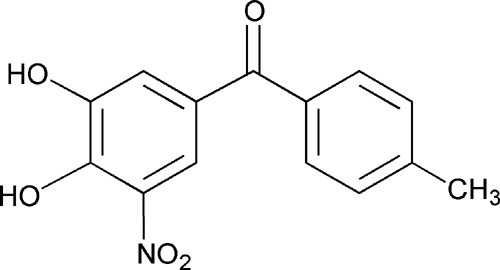
Uses
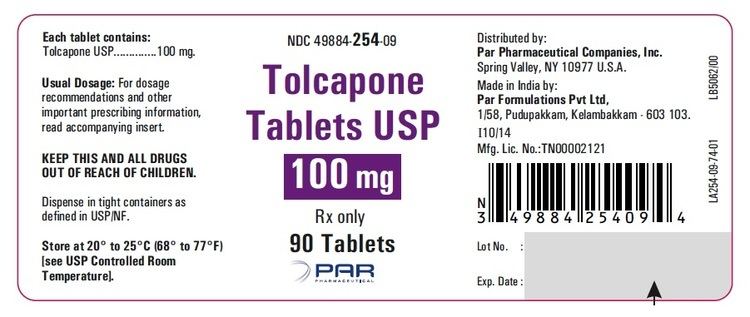
Tolcapone is used in the treatment of Parkinson's disease as an adjunct to levodopa/carbidopa medication that is conventionally paired with an aromatic L-amino acid decarboxylase (AADC) inhibitor.

Normally, administration of levodopa is compromised when COMT converts it to 3-methoxy-DOPA. By preventing this effect, more of the levodopa that is administered reaches the CNS. Additionally, levodopa that is in the CNS, after being converted to dopamine, will not be degraded by COMT when tolcapone inhibits COMT activity.
Chemistry

Tolcapone is a yellow, odorless, non-hygroscopic, crystalline compound with a relative molecular mass of 273.25 g/mol. The chemical name of tolcapone is 3,4-dihydroxy-4'-methyl-5-nitrobenzophenone. Its empirical formula is C14H11NO5.
History
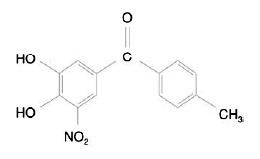
Tolcapone was introduced into European Market August 1997 and subsequently into the United States Market in March 1998. Liver toxicity or hepatoxicity was reported in four people who were administered tolcapone, 3 people died due to complications. Consequentially, the marketing authorization of tolcapone was suspended from December, 1998 until August, 2004 when it was lifted. In November 1998, the company that manufactured tolcapone voluntarily removed the drug from the market. The authorization was then renewed on August, 2009.
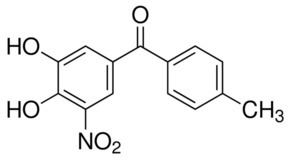
As a result of reported complications, the U.S. Food and Drug Administration (FDA) issued a black box warning for tolcapone and label revisions that aimed to regulate the monitoring of those prescribed tolcapone for PD in November 1998. A number of other countries withdrew tolcapone from the market; Australia in February 1999, Bulgaria in April 1999, Iceland in November 1998, Lithuania in December 1998.
Pharmacodynamics
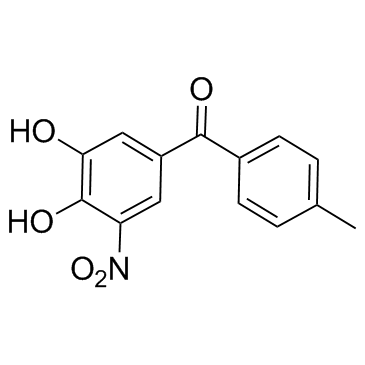
Tolcapone binds to the catalytic center of COMT in both peripheral and central nervous systems with greater affinity than any of the three catecholamine, including levodopa. It thereby prevents the 3-O-methylation of L-DOPA (3-hydroxy-L-tyrosine) by COMT which produces 3-O-methyldopa, a major metabolite that competes with levodopa to cross the blood–brain barrier. Thus, tolcapone improves the bioavailability and reduces the clearance of levodopa and subsequently dopamine from the central nervous system (CNS).
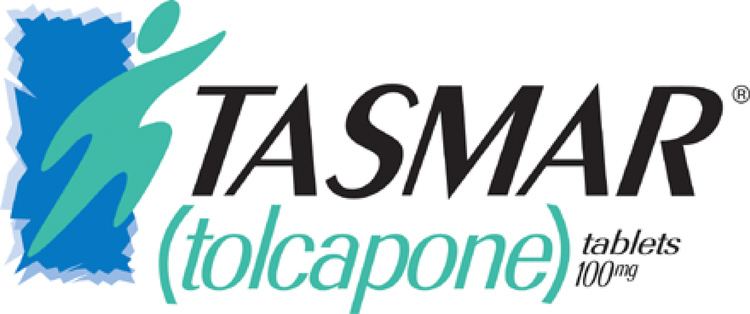
The strength of the binding affinity of tolcapone, represented by the inhibition constant Ki (2.5 nM), can be thought of as the dissociation constant for enzyme and inhibitor complex kinetics. Maximum catalytic activity denotes the efficacy of tolcapone (Vmax = 58.4 pmol/min·mg).
Pharmacokinetics
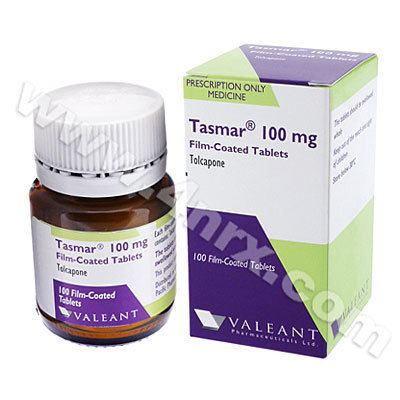
Typical dose of tolcapone is 100 or 200 mg, orally administered three times daily. The half life of tolcapone is 2–3 hours, volume of distribution (Vd) being 0.3 L/kg (21 L in average 70 kg person) and bioavailability about 60%.
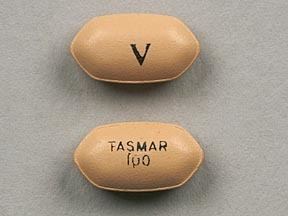
Tolcapone has the ability to cross the blood–brain barrier and thus exerts its COMT inhibitory effects in the central nervous system (CNS) as well as in the periphery.
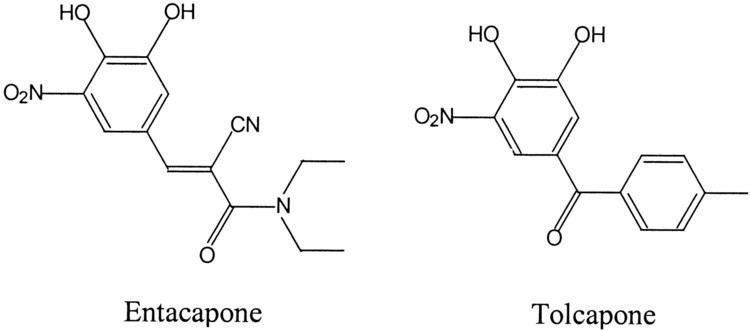
99% of tolcapone is in monoanionic form when in body because the physiological pH is 7.4. Tolcapone penetrates the blood-brain barrier better than two other nitrocatechols such as nitecapone and entacapone because it has higher lipophilicity due to its R-substituent. Partition coefficients quantify the ability of the molecule to cross the blood-brain barrier. LogPIdce= 0.2, –1.4, –0.4 for tolcapone, nitecapone and entacopone respectively. Partition coefficients in this case were measured in 1,2-dichloroethane/H2O solution which caused molecules to be in ionized form. There is no current explanation for how these charged molecules permeate the blood-brain barrier.
Treatment
Tolcapone is administered adjunct with levodopa and AADC inhibitor because it increases the bioavailability of levodopa. Since tolcapone has a greater affinity for COMT, it inhibits the enzyme from methylating levodopa. This results in greater levels of levodopa and increases the time period before clearance.
Tolcapone helps alleviates the issues with levodopa 50% of PD patients have experienced. Without administration of tolcapone, the beneficial effects of levodopa have worn off resulting in motor fluctuations.
In comparison with entacapone, another nitrocatechol COMT inhibitor, tolcapone has longer half life (2.9 hours vs. 0.8 hours), and can better penetrate the blood–brain barrier in that it acts both centrally and peripherally. However, entacapone is less toxic in regard to liver function.
Adverse effects
Tolcapone has demonstrated significant hepatotoxicity that limits the drug's utility. Entacapone, another COMT inhibitor, is an alternative selection for levodopa adjunct therapy in the treatment of Parkinson's disease, largely since it has a more favorable toxicity profile.
This hepatoxicity can be attributed to elevated levels of transaminases, but studies have shown that minimal risk exists for those without preexisting liver conditions when their enzyme levels were being monitored. No clear mechanism is implicated in tolcapone induced liver toxicity, but it has been hypothesized that it has something to do with abnormal mitochondrial respiration due to the uncoupling of oxidative phosphorylation.
Other side effects that result from the administration of tolcapone regard the increase in dopaminergic activity, digestive symptoms and liver function. Treatment with tolcapone runs the risk of eliciting or prolonging dyskinesia; this can be counteracted by decreasing the dose of levodopa. This occurs because the administration of tolcapone results in the accumulation of the biological methyl donor S-adenosyl-L-methionine (SAM) in the striatum that works to induce symptoms of PD.
Digestive symptoms include nausea, diarrhea, orthostatic hypotension, urine discoloration and dizziness. Tolcapone causes more severe diarrhea than entacapone.
Synthesis
A synthesis of tolcapone proposed in 2008 begins with a Grignard reaction between a benzaldehyde derivative and p-tolyl magnesium bromide. The alcohol thus produced is then converted to a ketone using sodium t-butoxide. The benzyl protecting group is removed by palladium-catalyzed hydrogenation in the presence of ammonium formate. A nitro group is introduced at the 5-position adjacent to the hydroxyl group unmasked in the cleavage of the benzyl ether. The synthesis ends with cleavage of the methoxy group using aluminum chloride to yield the product alcohol.
